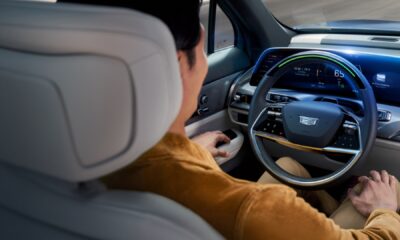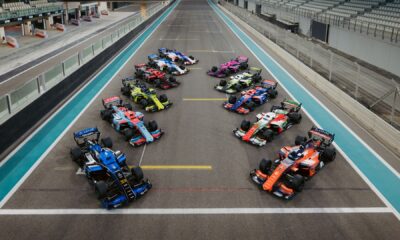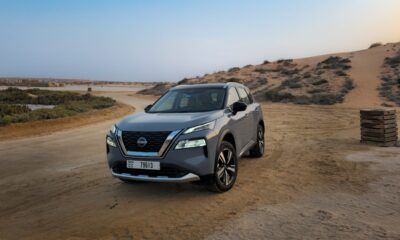Automotive
2025 Chevrolet Corvette ZR1: The Fastest, Most Powerful Corvette Ever

Chevrolet has unleashed the unthinkable in the Corvette ZR1. The King of the Hill returns with the most powerful V8 ever produced in America from an auto manufacturer, mind-bending specs, and iconic design to challenge the world’s best supercars in both coupe and convertible variants.
“The team that revolutionized Corvette with a mid-engine architecture took on another challenge: take ZR1 to the next level,” said Scott Bell, vice president, Chevrolet. “Corvette ZR1 is about pushing the envelope with raw power and cutting-edge innovation. From Stingray, to Z06, E-Ray, and now ZR1, the Corvette family continues to elevate with each new iteration — and challenge the best in the world.”
Pushing the boundaries of the Small Block
ZR1’s 5.5L LT7 twin-turbocharged DOHC V8 engine starts with the same architecture as Z06’s LT6, the most powerful naturally aspirated production V8 engine ever, and takes it to the next level with twin turbochargers — the first time ever for a factory Corvette.
Dubbed the “Small Block Gemini” architecture, the LT6 program was only the beginning as engineers dual-pathed a goal: to create massive power, capability, and character from naturally aspirated and turbocharged flat plane crankshaft twin engines. With these goals in mind, engineers did not create an LT6 with turbochargers, but instead changed and optimized virtually every system for a boosted application.
Corvette ZR1’s 5.5L, twin-turbo DOHC flat-plane crank LT7 engine is the result of engineering prowess and pushing the boundaries of what the engine architecture can do. Thoughtful planning produced the best performance from forced induction, married with the 5.5L flat-plane engine architecture.
Unique to the 5.5L LT7 twin-turbo V8:
- • Head castings with unique ports and a larger combustion chamber
- • Valve train timing and lift profile optimized for forced induction with higher exhaust temp enabling exhaust valves
- • Completely new intake system tuned for twin turbochargers
- • CNC machined combustion chamber, exhaust, and intake ports specific to the LT7
- • Dual, ported shroud, ball bearing, mono-scroll (76 mm) turbochargers integrated with the exhaust manifold to reduce the volume and distance from the exhaust valve to the turbine wheel for quick response with electronic wastegates
- • Intelligent anti-lag engine calibration techniques specifically for ZR1 that adapt and react to driving style
The LT7 engine also builds upon this engine architecture with:
- • Added block and head machining to support turbo cooling and oiling
- • Counterweight changes to account for a unique piston, and unique connecting rod for the crank train
- • A secondary port fuel injection system added to deliver the needed additional fuel to support the engine’s massive output
To support the dramatic increase in power from the LT7 engine, engineers made numerous changes to the Corvette ZR1’s eight-speed dual-clutch transmission, including:
- • Inner and outer input shaft upgrades
- • Increased gear capacity with strength increased via shot peening for all gears
- • Final drive refinements
- • Oil management to support increased vehicle longitudinal and lateral capability
- • Increased control valves to accommodate the higher required clutch clamp load for LT7
The LT7 engine is purpose-built to accomplish its four-figure horsepower mission with no compromises in componentry and maintains the rev-happy character that is the heart of the Small Block Gemini engine family. It will be hand-assembled by the master engine builders at the Performance Build Center, part of the Bowling Green Assembly Plant in Kentucky.
Enabling speed with ease
Purposeful aerodynamics provide the most downforce ever from a Corvette with over 1,200 pounds (544 kg) at top speed.
The Corvette ZR1 offers speed on tap like no Corvette before it. Two distinct setups, complete with Magnetic Ride dampers, accomplish this. The standard Corvette ZR1 chassis arrives with a sleeker body with lower drag and a small spoiler with customer-adjustable short and tall wickers. It also includes a standard carbon-fiber front splitter, rocker moldings, side intake with integrated brake cooling, and front underwing with stall gurney deflectors. Michelin Pilot Sport 4S tires wrap 20-inch front, and 21-inch rear wheels. The standard chassis blends the best of on-road comfort and track capability with this setup.
Corvette ZR1 dispatches the world’s toughest tracks with ease, not only with the power from the 5.5L LT7 engine, but also due to additional, specific aerodynamic and cooling changes found throughout the car. These include:
- • Flow-through hood: Air enters the front grille, flows through the intercooler heat exchanger, and exits the hood to increase front downforce and cool charged air temperatures.
- • Carbon fiber side profile air ducts: Clean, cool air is funneled through ducts, which are cleanly integrated into the signature wishbone bezel behind the cabin doors to cool the rear brakes through an intricately designed system that doesn’t impact rear wheel travel.
- • Unique fresh air intake ducts: Carbon fiber inlets located on top of the coupe rear hatch ingest air to cool the turbo compressor inlet air temperatures.
Corvette ZR1’s optional ZTK performance package unlocks a true track weapon. Notably, the ZTK package adds an aggressive, high-downforce rear wing, front dive planes, and a tall hood Gurney lip – all constructed from woven carbon fiber. Underneath, underbody strakes replace the standard front underwing stall Gurney to increase front downforce. The suspension tuning included in the ZTK package incorporates stiffer springs and adds Michelin Pilot Sport Cup 2R tires. Amid testing and development, the ZR1 tackled some the world’s most demanding racetracks, including the Nürburgring, Road Atlanta, and Virginia International Raceway.
Carbon Aero, featuring all aerodynamic equipment from the ZTK package, is available on the standard ZR1 chassis as well.
“We went into the ZR1 program with lofty goals, but even our first development tests on-track showed the teams were already exceeding them,” said Tadge Juechter, executive chief engineer, Corvette. “As we worked to develop this car, we continued to leap past expectations, and we knew we had a special Corvette on our hands.”
Controlling ZR1’s high performance is a new brake system. The brake package uses a revolutionary carbon ceramic rotor manufacturing technology to yield increased durability and reduced brake component temperatures. Front rotors measure 15.7 inches (400mm) in diameter and rear rotors 15.4 inches (390mm) in diameter — the front rotors are the largest ever equipped on Corvette. In just 24.5 seconds, the Corvette ZR1 goes from 80-200 mph and back to 80 mph (129 – 321 – 129 kph) — 22% quicker than the C7 Corvette ZR1, and 53% quicker than the C6 Corvette ZR1.
Designed for the split window’s return
For ZR1, function and form quickly took hold to create an instant icon — an icon worthy of the historic split window’s return.
“We didn’t approach this decision lightly, we know this is a beloved element from Corvette’s history,” said Phil Zak, executive design director, Chevrolet. “Not only does this element provide function, but we were able to integrate passionate design into the form and do it in a way that paid homage to Corvette’s history. ZR1 felt like the right time to bring the split-window back.”
Last seen on the C2-generation Corvette, and quietly previewed on the Corvette Z06 GT3.R race car, the split-window style capitalizes on the design statement that is Corvette ZR1. While serving as a statement piece, this carbon fiber “spine” between the two rear windows, available in exposed weave or body color, provides increased heat extraction from the engine compartment, working in parallel with numerous other cooling elements throughout ZR1.
The teams worked to elevate the striking design first revealed with the eighth-generation Corvette Stingray and accentuate lines that evoke the car’s sense of motion — but the design’s function also helps it perform. Teams looked at every component of Corvette ZR1 to ensure cooling and aerodynamics remained top of mind, and any change accomplished the car’s mission: performance.
Additional changes include:
- • A carbon fiber roof to reduce mass and lower the center of gravity for both coupe and convertible
- • Unique aluminum wheel design available in four finishes, including Edge Blue — an homage to ZR1’s signature color cue
- • Optional new carbon-fiber wheel design, exclusive to ZR1, to further reduce mass
- • LT7 engine intake finished in Edge Blue — delivering an engine that looks as good as it performs
The Corvette ZR1’s cockpit dials up the attention to detail, notably with unique ZR1 badging found on an interior plaque, the sill plates and steering wheel. A new finishing stitch pattern for the doors, specific to ZR1, is available on the 3LZ trim. A boost gauge is also present, denoting the first factory turbocharged Corvette in the nameplate’s history.
Providing further choice to customers, the Corvette ZR1 will provide a roster of customization between exterior and interior colors. Shared with the 2025 Corvette lineup, new colors such as Competition Yellow, Hysteria Purple, and Sebring Orange headline updates. The latter recalls a fan-favorite hue from the previous C7-generation Corvette ZR1.
Inside, a new Habanero interior is available, as is a Blue Stitch option. Various full-length racing stripes, brake caliper colors, including an exclusive blue for the calipers, seat belt colors and more will also be available.
King of the Hill coming next year
Corvette ZR1 will enter production in 2025 and will be built at General Motors’ Bowling Green Assembly Plant in Kentucky. It joins Corvette Stingray, Corvette Z06 and Corvette E-Ray to continue elevating the Corvette family. Further details on price and availability will be shared closer to production.
Cross flags closers:
- • On its first lap at the Milford Proving Ground’s MRC test track, the new ZR1 clocked a faster peak speed than the production C7 ZR1.
- • Engineers clocked a sub-10-second quarter-mile time on the Corvette ZR1’s first launch.
- • All four test drivers clocked over 200 mph (321 kph) peak speed on their very first laps at the Nürburgring with ease.
- • LT7 produces more power than two LS7 engines, the legendary 7.0L V-8 from the sixth-generation Corvette Z06 – akin to one LS7 engine per bank.
The Corvette ZR1 adds to the Chevrolet’s line up of performance cars under the Corvette brand including the Stingray, Z06, and recently available on to order; the E-ray. The Middle East is renowned globally for its appreciation of fast, powerful, beautiful sports cars and the arrival of the ZR1 will take this passion stratospheric.
Automotive
How Machine Learning Makes Super Cruise Smarter Every Day
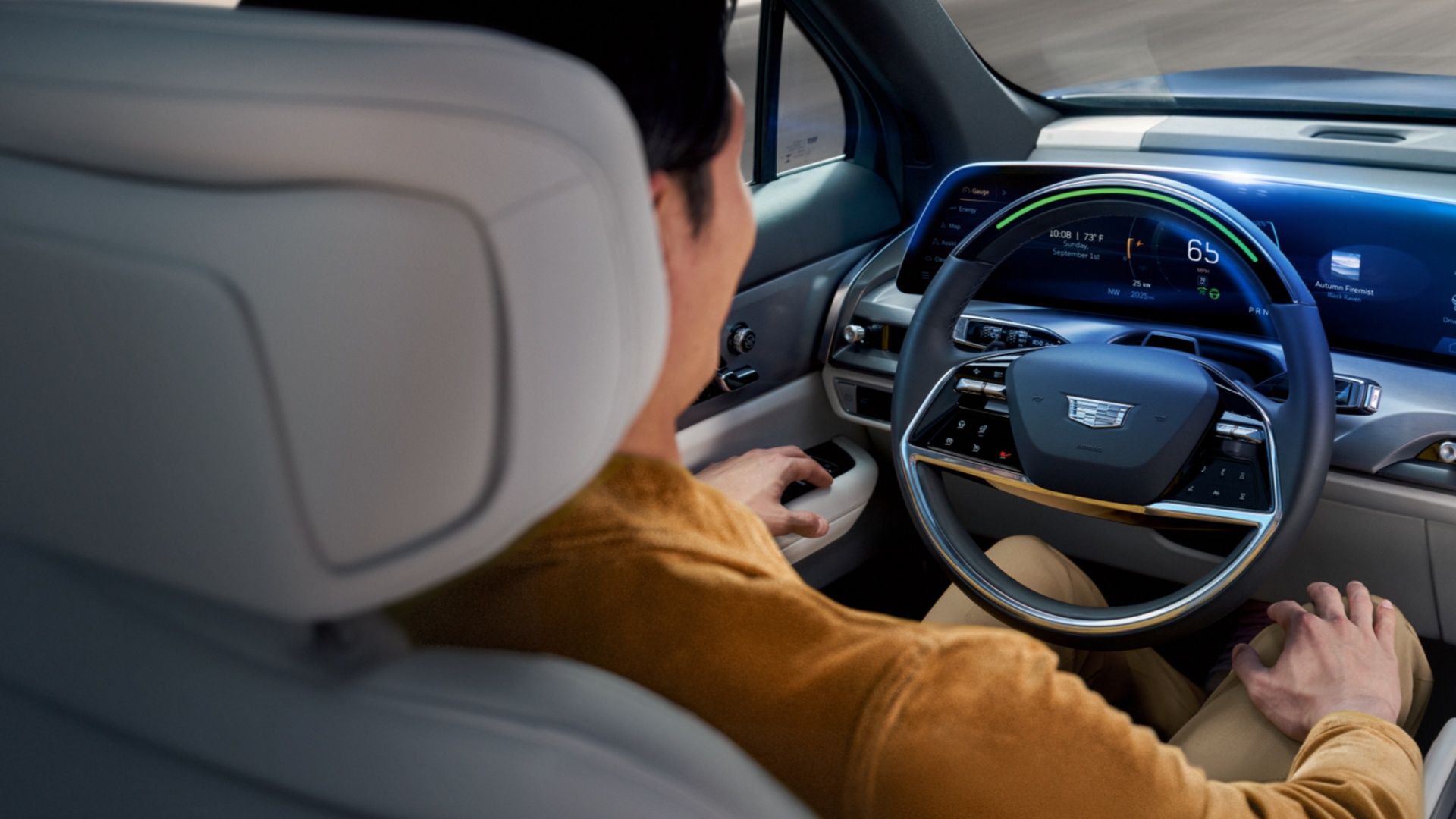
When technology works effortlessly, it’s easy to forget the incredible engineering behind it. That was the goal with GM’s Super Cruise hands-free driver assistance technology. Super Cruise is designed to execute precise lane centering, perform smooth lane changes, interact with a driver’s requests and handle steering maneuvers. These advanced capabilities are managed by a single, modular software stack called the Unified Lateral Controller, or ULC. Looking inside, GM engineers built a self-learning system made up of machine learning algorithms to update the vehicle’s dynamics and controls. The algorithm makes quick decisions to ensure efficiency.
Imagine you’re driving with Super Cruise engaged, and you initiate a left lane change with the turn signal. Super Cruise then starts to shift the vehicle into the left lane. But let’s say you then decide to stay in the current lane, so you signal to the right. Super Cruise will respond by bringing you back to the center of the original lane – a seemingly effortless transition, but one that requires complex and rapid calculations.
Super Cruise needs to maneuver as naturally as possible for drivers to remain comfortable and confident as they drive hands free. Diving deeper, the ULC must consider many data inputs: The curvature of the road from the LiDAR map data, lane geometry from the cameras, trajectory of the vehicle based on current speeds, vehicle load, current weather conditions, and the behavior of surrounding vehicles–all in a matter of seconds.
One of the unique features of Super Cruise is its ability to maintain precise hands-free lane centering while towing a trailer – a capability unmatched in the industry. One of Super Cruise’s standout features is its ability to maintain precise, hands-free lane centering even while towing a trailer—a capability unmatched in the industry and currently available on select GM vehicles. With a trailer attached, ULC automatically accounts in real time for the additional mass and its effects on vehicle dynamics, optimizing steering commands to control both the vehicle and the trailer.
The self-learning system analyzes real-time sensor data, enabling Super Cruise to make more accurate decisions and perform proactive adjustments, improving driver comfort and confidence over time. That allows Super Cruise to adapt for each vehicle and each driver in different environmental conditions.
Let’s go back to our trailering example: Tight lateral control is important for keeping both the vehicle and the trailer centered in the lane. The model learns how the presence of the trailer changes the vehicle’s steering response and works with the ULC to optimize its responses and keep the vehicle and trailer centered in the lane. This model also scales Super Cruise enabled by OnStar , and is now available across 13 vehicle models on select trims, and counting . No matter the shape, size, or weight of the vehicle, the ULC and our self-learning algorithms can adapt, reducing complexity. We’re bringing Super Cruise to consumers on more models, offering consistent, predictable, safe hands-free driving.
Automotive
Goodyear and Peugeot Drive the Future of Intelligent Mobility with the Polygon Concept Car

Goodyear and Peugeot have partnered to shape the future of intelligent mobility with the unveiling of the Peugeot Polygon concept car. This next-generation vehicle features Goodyear SightLine—an advanced suite of intelligent tire technologies—integrated directly into the cockpit for the first time alongside three bespoke Goodyear tires tailored to the car’s versatile configurations.
The Peugeot Polygon is designed to adapt to a range of driving styles through three distinct configurations, Urban, Player and Explorer, and Goodyear’s tires and solutions are uniquely designed to support the vehicle’s purpose.
The collaboration marks a milestone moment and a bold move toward seamless connectivity between vehicle and tire, delivering enhanced safety, performance, and driver confidence.
Goodyear SightLine Technology: Intelligence at Every Turn
Goodyear SightLine is a proprietary suite of smart tire technologies that provides real-time insights for safety and performance improvements in vehicles, from tire properties estimation, tire health information to road conditions. These insights can be displayed directly on the driver’s heads-up display, ensuring clarity and control throughout every journey, or it can be integrated into other advanced systems of a vehicle, allowing it to mitigate situations that are driver dependent today.
Across all Polygon configurations, SightLine features are accessible from the cockpit, offering:
• Tire Maintenance: Integrated tire wear monitoring enables vehicles to automatically adjust performance settings as tires age—helps ensuring optimal handling and safety throughout their lifecycle.
• Safe Driving: SightLine predicts and detects aquaplaning risks, allowing vehicle control systems to respond instantly and maintain stability, even in challenging conditions.
Goodyear delivers insightful journeys to Polygon drivers thanks to its integration with Peugeot Drive-by-Wire technology.
Ben Glesener, senior technology director, Product Development, Consumer EMEA, commented:
“SightLine represents more than technology—it’s a vision for connected mobility. By partnering with Peugeot, we are envisioning an ecosystem where tires become active contributors to vehicle intelligence, shaping a smarter future.”
Already available in several global markets, Goodyear SightLine is not just a concept—it’s a proven smart tire service ready for real-world applications.
Goodyear Tires: Built for Today’s Roads and Tomorrow’s Possibilities
As part of this visionary collaboration, Goodyear engineered three unique tires—each custom-designed to match the aesthetic and performance needs of the Polygon’s configurations:
- The Urban and Player tires feature the legendary Eagle F1 tread pattern, celebrating its 45th anniversary in 2025—a symbol of high-performance heritage.
- The Explorer tire pays tribute to the iconic Goodyear Wrangler, incorporating its rugged tread design to deliver traction to unleash unforgettable off-road experiences.
Beyond performance, the sidewall designs were crafted to visually express a new era of automotive innovation using coloring and laser technologies —where tire aesthetics and functionality converge to push the boundaries of design.
This collaboration showcases Goodyear’s long-standing expertise in combining craftmanship with premium manufacturing technologies to deliver the highest levels of customization from product performance to aesthetics.
Together, Goodyear and Peugeot are setting new trends and driving a new era—where every journey is smarter and more expressive.
Automotive
Stage Set for World’s Largest Autonomous Race as A2RL Reaches Full Fan Capacity at Yas Marina Circuit
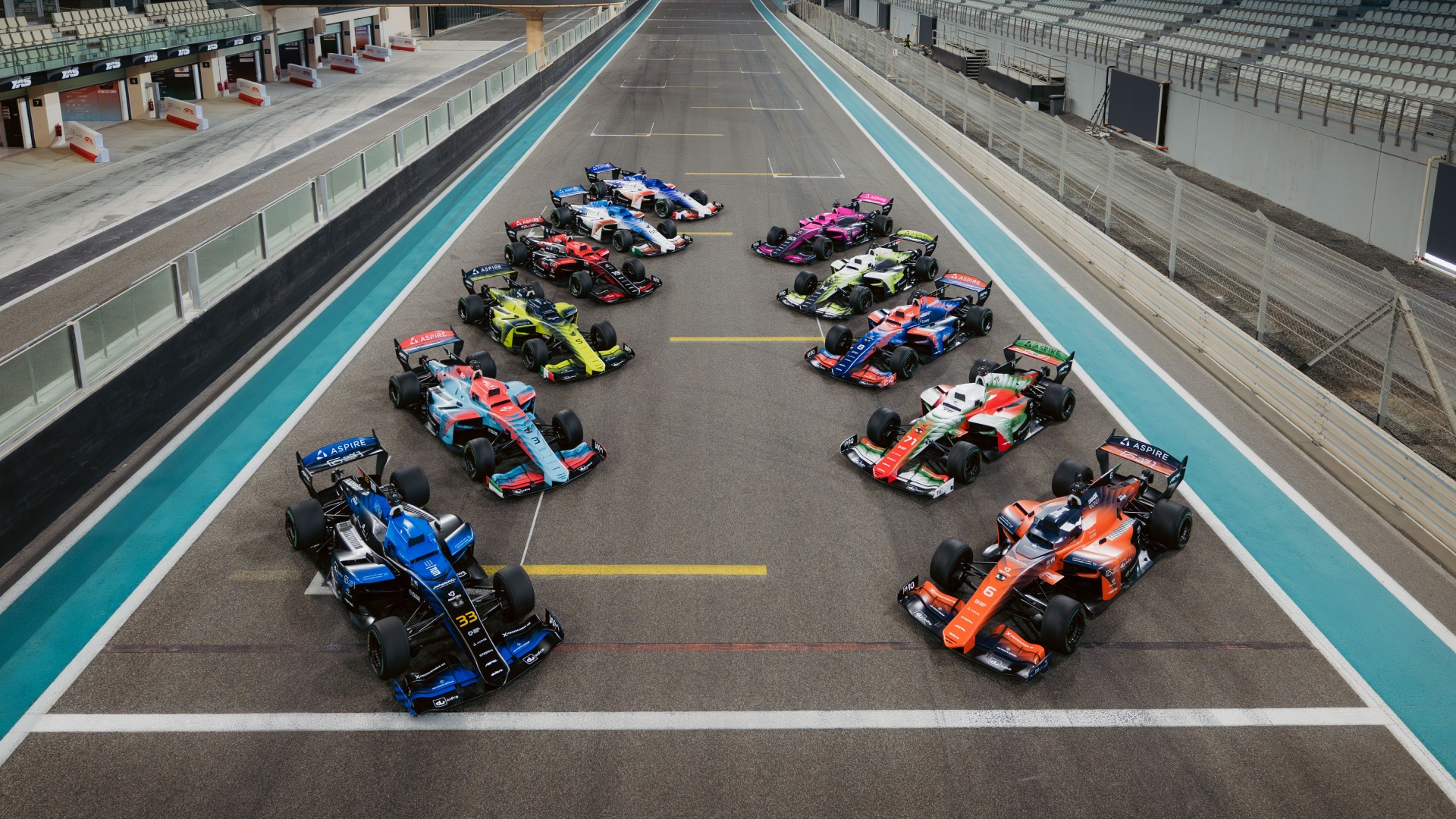
The world’s largest autonomous car race will take place in Abu Dhabi on the 15th of November, as 11 teams from across the globe compete at the frontier of robotics, autonomy and AI for a US$2.25 million prize pool. A2RL Season 2 has been 18 months in the making, with the six fastest teams making it through the tough qualification process to the Grand Final. Ticket allocation for the Yas Marina Circuit event has once again reached full capacity of the main grandstand, as motorsport and technology enthusiasts excitedly prepare to witness an AI competition unlike any other.
Grand Final: Front row seat to AI history
The A2RL Grand Final will mark the first time that six fully autonomous racecars will compete wheel-to-wheel on track. The six teams – TUM, Unimore, Kinetiz, TII Racing, PoliMOVE and Constructor – were determined by a rigorous qualification process in October. Representing Germany, Italy, and the UAE, they will compete in a 20-lap, multi-car race to crown the A2RL Season 2 Champion. Reigning Champions, TUM, have qualified in pole position after a fierce ‘Multi-Car Qualification’ sprint race against rival Unimore, setting the stage for a historic showdown.
For the remaining five teams, A2RL will host a Silver Race, offering them the opportunity to push their algorithms to the limit and cement their overall position in the standings. The Silver Race teams are RAPSON, Code 19, Fly Eagle, FR4IAV and TGM Grand Prix.

Human vs AI: Performance gap closing
Pre-season build-up for the race has seen record-setting performance as the gap between human and AI performance narrows. During qualification, Italian team Unimore was the first to beat a benchmark lap time set by a human racing driver while testing.
This demonstration of machine precision versus human instinct, and the rapid evolution of AI performance, will be showcased on race day. Reigning champion TUM will have the privilege of racing against former F1 driver Daniil Kvyat in A2RL’s second Human vs AI showcase. A close battle is expected in this exhibition, following record-breaking pace from teams during qualifying.
Supercars, Fan Zone, and more
Kicking off the evening’s main events, Group 63 will take to the track for a spectacular Supercar Parade Laps display, setting the stage for the autonomous race. This will be followed by awards for the A2RL STEM Competition, which involved 140 students from across all seven Emirates racing AWS DeepRacer 1/18th-scale autonomous cars, a mirror of the A2RL competition.
This year’s world-class Fan Zone will offer an immersive experience for all ages. It will feature humanoid robot showcases, interactive games, hands-on tech activations, live entertainment, and family-friendly attractions that will bring the excitement of autonomous innovation beyond the track.
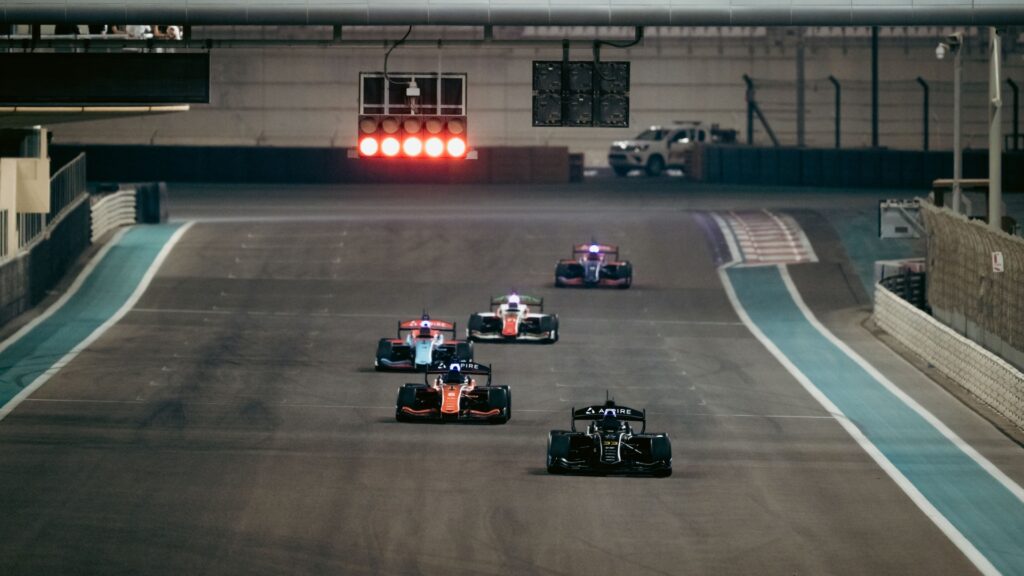
The race will be broadcast globally this Sunday, 16th November at 3pm GST, on the Abu Dhabi Media Network, StarzPlay, Motorsport TV and the official A2RL YouTube Channel. Once again, fans can step right into the action with A2RL’s live VR platform, experiencing the track, live car data, and high-speed action unfolding all around them, in real time.
A2RL is supported by SteerAI, alongside leading partner du; official partners AWS and Abu Dhabi Mobility; official supporters Wio and Castore; technical partners PACETEQ, Live in Five, Meccanica 42, and Vislink; as well as event partners Abu Dhabi Gaming, Miral and the UAE Cybersecurity Council.
-

 Tech News1 year ago
Tech News1 year agoDenodo Bolsters Executive Team by Hiring Christophe Culine as its Chief Revenue Officer
-

 VAR7 months ago
VAR7 months agoMicrosoft Launches New Surface Copilot+ PCs for Business
-

 Tech Interviews2 years ago
Tech Interviews2 years agoNavigating the Cybersecurity Landscape in Hybrid Work Environments
-

 Tech News4 months ago
Tech News4 months agoNothing Launches flagship Nothing Phone (3) and Headphone (1) in theme with the Iconic Museum of the Future in Dubai
-

 Tech News2 years ago
Tech News2 years agoBrighton College Abu Dhabi and Brighton College Al Ain Donate 954 IT Devices in Support of ‘Donate Your Own Device’ Campaign
-

 Editorial12 months ago
Editorial12 months agoCelebrating UAE National Day: A Legacy of Leadership and Technological Innovation
-

 VAR1 year ago
VAR1 year agoSamsung Galaxy Z Fold6 vs Google Pixel 9 Pro Fold: Clash Of The Folding Phenoms
-

 Cover Story9 months ago
Cover Story9 months agoUnifonic Leading the Future of AI-Driven Customer Engagement






